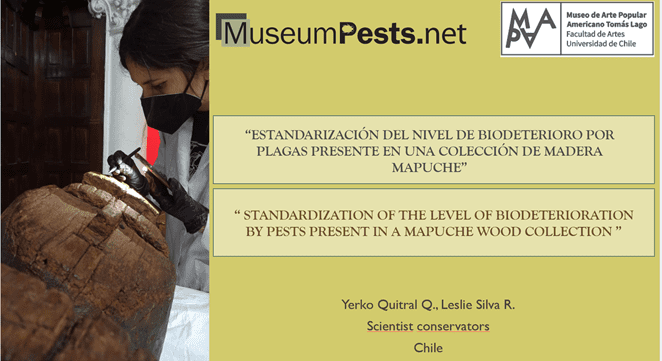Intro to the MuseumPests Working Group
Matthew Mickletz and Rachael Arenstein, MPWG Co-Chairs
Short presentations on IPM observations, research and developments are an integral part of the MuseumPests Working Group’s annual meeting. To expand participation and reach, the MPWG is hosting its second Public Presentation Session on IPM in the cultural heritage community. We will offer a brief overview of the Working Group, our resources and how to get involved.
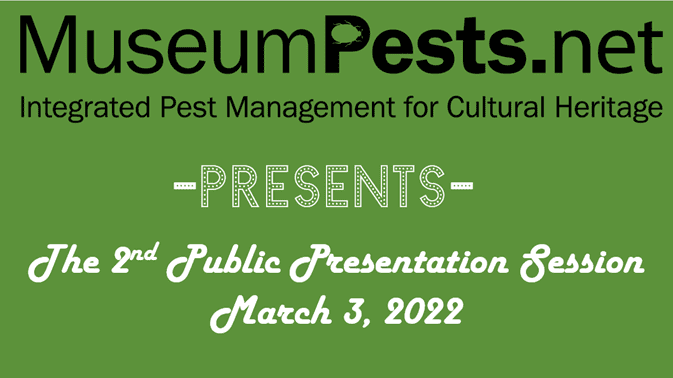
Climate change and its effects on indoor insect pests and fungi in Austrian museums
Pascal Querner, Katja Sterflinger, Katharina Derksen, Johanna Leissner, Bill Landsberger, Peter Brimblecombe, Natural History Museum Vienna, Austria
Climate change also affects the biodiversity and activity of pests in-side of museum buildings. A further challenge is the introduction of new species (neobiota). Most of our cultural heritage is presented and stored within buildings, so changes in indoor climate also affects insect pests and fungi within museums, storage depositories, libraries and historic properties. This paper presents an overview of these complex interactions between outdoor climate, indoor climate and pest abundance and activity. Warming of indoor climate (without sufficient climate regulation) and an increased frequency or intensity of extreme weather events are two important drivers affecting indoor pests like insects and fungi, which can severely damage collections. Increases in their activity and new species are already being found. A new research project in 20 Austrian museums is presented.
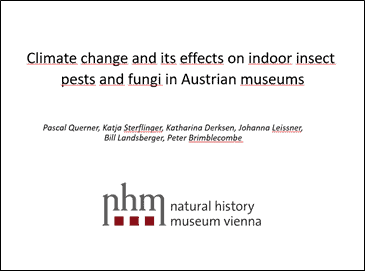
Advancements in remote monitoring for pests in museums
Adrian Doyle, British Museum; Pat Kelley and Ethan Estabrook, Insects Limited
One of the fundamental principles for effective Integrated Pest Management (IPM) is to regularly monitor for insect activity in collections areas, and traditionally collections care staff undertake monitoring on a quarterly basis. Resources are perhaps more readily available for these areas, but areas including packaging, crate and non-collections related spaces (e.g. plant rooms) are more challenging to ensure monitoring is undertaken as access is often controlled by other organisational departments such as Hard Services resulting in these areas often being overlooked. The British Museum has been undertaking a pilot research project to consider options in such areas with increasing webbing clothes moth counts which are a risk to local High Risk (highly munchable) collections including using external IPM contractors, training Hard Services staff in IPM and investigating remote monitoring systems. The use of remote pest monitoring is becoming more widely accepted and can be valuable tool. Remote pest monitoring can automatically provide important information such as the detection of pests, pest species, populations trends, and locations of pest captures. Obtaining this information on a more regular basis can allow users to make quicker and more effective pest management decisions. Insects Limited has developed a remote insect pheromone monitor, called the SightTrap, to capture images of an insect pheromone trap and upload information to a software called ForesightIPM. ForesightIPM counts the number of new insect captures, identifies insect species, records temperature and humidity, and trends capture data. ForesightIPM can be easily accessed to users through a website or phone app to view data.
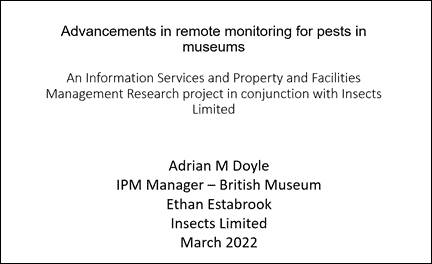
Preventive Conservation and Pesticide Use: Investigating Potentially Contaminated Ornithology and Mammalogy Collections in Zimbabwe’s Museums
Davison Chiwara, Siona O’ Connell, Maggi Loubser and Isabelle McGinn, University of Pretoria, South Africa
The preservation of natural history specimens has been heavily reliant on pesticide use. However, the treatment history of artefacts against pest attack has in general been poorly documented and much research in the global north has focussed on the use of pesticides and their potential negative health effects with repeated exposure. Research emanating from the global north has shown that some of the specimens collected in the 18th – 20th centuries were treated with hazardous insecticides such as arsenic and mercuric chloride. Such antiquated practices of pest management have since been largely abandoned in the global north in favour of integrated pest management practices. Many museums across Africa still rely heavily on chemical pest control. Natural history specimens at the Zimbabwe Museum of Human Sciences in Harare, for example exhibit unknown powders and residues, as well as naphthalene ‘mothballs’ on artefacts on open display, as well as in storage cabinets. This is likewise the case at the Natural History Museum of Zimbabwe in Bulawayo, which is one of the biggest museums with natural history collections in Africa. Its collections were obtained from across the globe including from the United States, Mexico, Britain, Denmark, India, China, Afghanistan, Kenya, South Africa, Botswana and Zimbabwe, and some date back from the 19th Century up to the present time. Institutions such as the Smithsonian, and British Museum amongst others formerly owned some of these collections at a time when it was commonplace to use pesticides. As the collection in Bulawayo is the largest of its kind on the continent, it has invaluable potential for education as part of the school curriculum, as well as documenting historical and modern patterns of biodiversity. The repeated exposure to potentially hazardous residues on specimens could negatively impact on the use of these collections, as well as the health of its users, and the present research thus aims to identify if any potentially harmful contaminants are present on specimens through the use of XRF testing at the Natural History Museum of Zimbabwe in Bulawayo. This research is the first of its kind for Zimbabwe, where the history of pesticide use is poorly documented, and if the presence of such hazardous substances are indeed identified, this research could provide impetus for improved curatorial practices in line with international best practice.
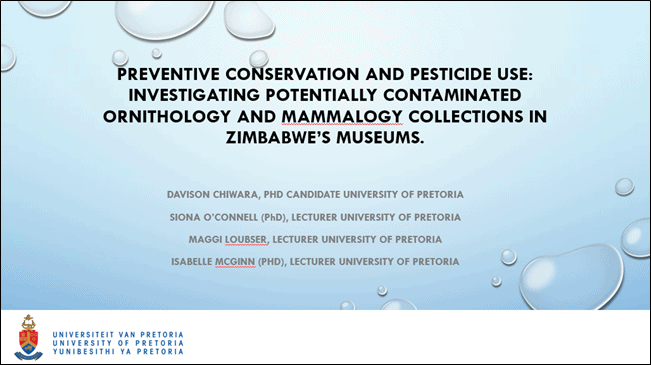
Digital Twin + An Integrated Pest Management Case study
Armando Mendez, Richard Hinton & Eleanor Koller
The Digital Twin vision: To support a connected and evidence-led museum, the Digital Twin initiative seeks to use our myriad data in context to build a digital representation of the NHM in order to optimise operations, identify and understand trends, and even predict the future. Proof of value activities to date have included optimised Retail reporting, a Museum visualisation tool and using AI to inform Integrated Pest Management. The presentation will describe the Digital Twin vision initiative and share the detail and findings of the IPM case study, which looked at use of AI for achieving predictive analysis on pest prevalence.
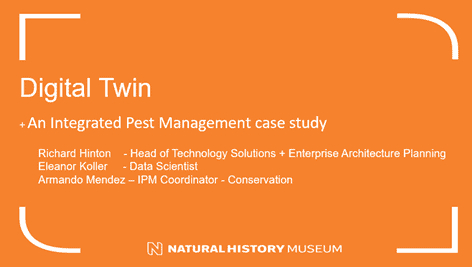
Humidity regulated heat treatments for insect-infested artworks and heritage objects
Nikolaus Wilke, ICM / IPARC, Belgium
Heat can be used to kill insects. When treating artworks and heritage objects the warm air must be humidified to prevent dimensional changes in hygroscopic materials. In the past heat was mainly used to treat infested buildings. Today, the method is used by ICM Integrated Contamination Management in Brussels, London and Berlin to treat even Italian Renaissance paintings, complex polychrome / gilded objects, contemporary installations, natural history specimens and ethnological collections. Furthermore, an adaption of the method can be used to decontaminate biocide polluted objects and collections; a scientific evaluation and study about the biocide decontamination will be presented at this year’s Florence Heri-Tech conference. The presentation will also introduce a mobile treatment project in Valencia, Spain, in which sixteen large sculptures by American artist Emilie Brzezinski were treated against a wood borer infestation.
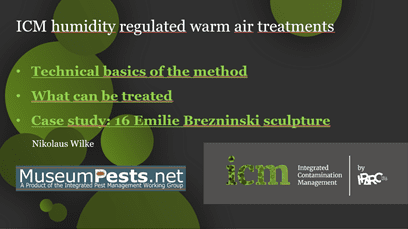
Humidity controlled heat treatment: a new pest treatment option at the British Museum
Fabiana Portoni, Nicola Crompton, Adrian Doyle, The British Museum, U.K.
The vast and varied collection at the British Museum benefits from having several pest treatment options available in house. The museum has a thermal chamber which can be used to complete both low temperature treatments and humidity controlled heat treatments. Whilst the low temperature treatment setting for the chamber has long been one of the standard treatment options, the use of the humidity controlled heat treatment cycle had not been explored as a standard treatment within the organisation until recently. Humidity controlled heat treatment is a good alternative to the standard low temperature treatment mode as it provides the possibility to treat materials that are not suitable to low temperature treatment due to changes in relative humidity such as objects with lamellar structures like ivory or mother of pearl. Moreover, the method is effective in treating objects in less than 24 hours. This is significantly faster than the standard low temperature cycle of 1 week and therefore a suitable option for objects with a tight treatment turnaround. This presentation will cover a series of tests, pilot treatment cycles and the successful treatment of a collection of over 300 objects with this new option. Humidity controlled heat treatment has now been officially added as one of the pest treatments available in house at the museum.
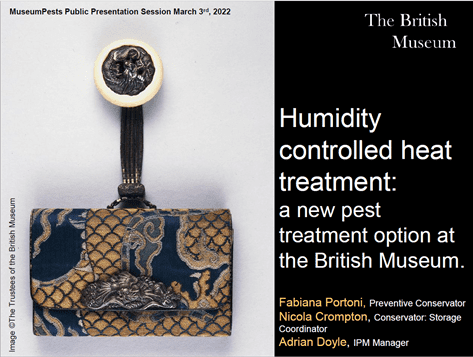

Creative approaches to Integrated Pest Management: engaging museum staff and creating buy-in
Abbie Griffiths Yale Center for British Art, USA
Integrated Pest Management is a critical component of collection care. At the Yale Center for British Art, a small team manages our recently re-invented, museum-wide IPM program to protect our collections from insect infestations and rodents. With such a small team, monitoring all corners of the museum takes a significant amount of time and energy. Because of this, it has been essential to increase incentives for all departments to participate in the IPM program. We have achieved an increased level of buy-in from general staff by highlighting and fostering positive interaction through the implementation of three creative campaigns, which have dramatically improved efficiency in our monitoring and prevention throughout the museum. The creative practices are as follows; Bug Jars with stickers identifying function, an intranet page for information and updates on IPM notifying all staff of notable pest occurrences, interactive IPM Bug Bingo and the incentive of being Bug King, Bug Queen, or Bug Tsar of the month. This presentation highlights the importance of increasing awareness and engagement from other departments through the novel and inclusive activities, as well as positive reinforcement. This multifaceted program fosters a sense of community and shared ownership toward the common goal of preserving and protecting our collection.
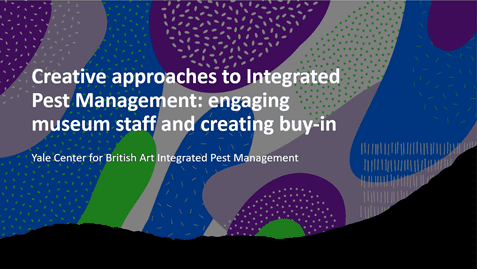
Selecting the Met’s Integrated Pest Management Vendor
Michael Millican, The Metropolitan Museum of Art, USA
In the summer of 2021 the Metropolitan Museum of Art’s IPM Working Group began the search for an integrated pest management vendor. The Met’s IPM WG developed an IPM Scope of Services for the museum and in coordination with the museum’s procurement department developed an RFP for IPM. This presentation will provide a brief overview of the development of the IPM scope of Services and the RFP process for selecting a new vendor.
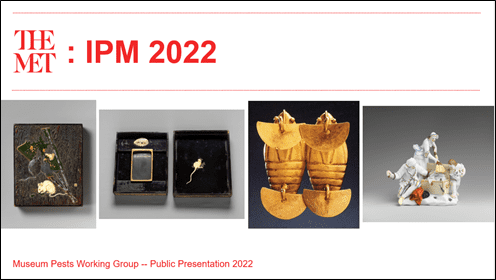
Update On The New Nitrogen Bubble At Historic New England
Adam Osgood, Historic New England, Pat Kelley and James Feston, Insects Limited, USA
Historic New England has been operating a nearly one thousand cubic foot, controlled atmosphere pest remediation chamber or “bubble” using CO2 providing successful treatments for nearly thirty years. Nearing the end of 2019, the bubble membrane was showing signs of wear and inefficiency and research began to explore what would be needed to update and possibly replace the system. In December of 2020 Historic New England received a grant to replace the CO2 based system with a novel system using Nitrogen. By March of 2021 early installations for the new system had begun and this was reported on in a presentation given at the MuseumPests.net Working Group event held that month. This presentation will serve as an update on the system which is now fully operational and as efficiencies continue to be refined.

Parasitic Wasps vs. Clothes Moths
David Stevenson, Canadian Centre for Architecture, Canada
Tricho Mite vs. Tineola Bisselliella (Wasps vs. Moths). Our museum had an infestation of clothes moths that came to light after reopening our galleries after a period of closure due to the pandemic. We did the requisite remedial work after our unfortunate discovery: cleaning, removal of infested or at-risk objects, CO2 treatment of the infested objects, installation of traps, and frequent inspection. The situation has greatly improved. In anticipation of an upcoming exhibition that will contain keratinaceous objects, we have decided to deploy a small number of parasitic wasps to combat the persistent yet very low-level presence of moths that remain in the building. This short presentation will attempt to describe the process, and for some, introduce the idea of parasitic wasps as a way of combatting Tineola Bisselliella, commonly known as clothes moths.
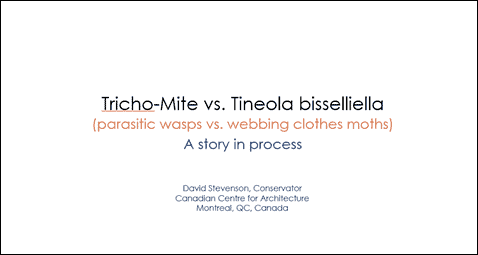
Estandarización Del Nivel De Biodeterioro Por Plaga Presente En Una Colección De Madera Mapuche
(Standardization of the Level of Biodeterioration by Pests Present in a Mapuche Wood Collection)
Yerko Quitral Q., Leslie Silva R., MAPA museum, Chile
Se ha presentado la aparición de termitas en depósitos, y posiblemente de carcomas dentro del museo, llevando a una infestación evidente del depósito, pero, con presencia y magnitud desconocida dentro de la colección de madera de los pueblos originarios – Mapuche e Isla de Pascua. El estudio de grandes volúmenes es un trabajo complejo, tanto por tiempo, infraestructura y recursos económicos, es por esto que en primera instancia se realizará un estudio de identificación del daño y magnitud, reconociendo el nivel de infestación en todo el museo, incluyendo, salas, depósitos, archivo y biblioteca, utilizando la fórmula adaptada para la obtención del Índice de Biodeterioro (BI) específico para plagas. En paralelo, para el estudio de la colección se realiza la estandarización para la identificación de biodeterioro específico del daño por termitas y/o carcomas en objetos de madera dentro de la colección Mapuche, utilizando dos objetos representativos, tanto por su importancia histórica como cultural. El primer objeto a evaluar es un Rewe o escalera de machi, figura antropomorfa esculpida en tronco, muy relevante para la sociedad mapuche debido a su uso espiritual y ceremonial. El segundo objeto es un Chemamull, tronco con figura antropomorfa que se ubica en los cementerios mapuches como cuidador de las almas entre el mundo de los vivos y los muertos. Evaluando características como presencia de: delaminación, fragilidad, huevos o larvas, insectos vivos o muertos, entre otros. Para la correcta identificación se utilizarán cámaras espectroscópicas, luz UV, microscopía in situ y óptica como metodología fundamental. Tanto la evaluación del edificio, como de la colección ayuda en la identificación del grado de biodeterioro por plagas de forma específica, priorizando metodologías de intervención y estabilización para aquellos objetos en mal estado, y al uso correcto de los recursos económicos.
Termites, and possibly woodworm, have been identified in the storage spaces inside the museum which indicate an evident infestation. The exact location and magnitude of the infestation is unknown, and the objects affected involve a collection of wooden objects of indigenous Mapuche and Easter Island peoples. The study of large groups of objects is complex work due to time, infrastructure and budget restraints. For this reason, there will be an initial investigation to identify damages and magnitude of the infestation. We will survey the level of the infestation across the museum including exhibition spaces, storage areas and archive and library spaces using the formula adapted for Biodeterioration Index (BI) for pests. At the same time, two representative affected wooden objects from the Mapuche collection have been chosen for in-depth evaluation due to their historical and cultural importance. The first object is a Rewe or “machi ladder”, an anthropomorphic figure carved on a large log, relevant to Mapuche society for its spiritual and ceremonial use. The second object is a Chemamull, also a carved anthropomorphic figure, normally placed in Mapuche cemeteries as a guardian of the souls between the worlds of the living and the dead. We will evaluate various characteristics such as presence of: delamination, fragility, eggs or larvae, live or dead insects, etc. by using spectroscopic cameras, UV light, in-situ microscopy and visual examination. The inspection of both the building spaces as well as specific objects in the collection will help identify the extent of the infestation, allowing us to prioritize interventions and stabilization procedures for the affected objects and determine the appropriate allocation of available economic resources.
